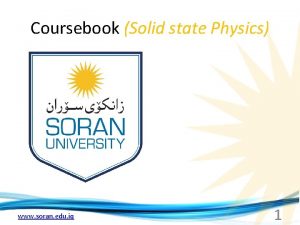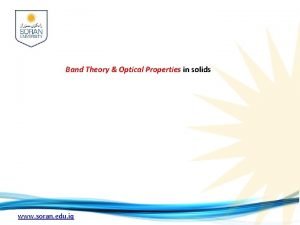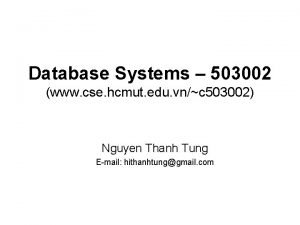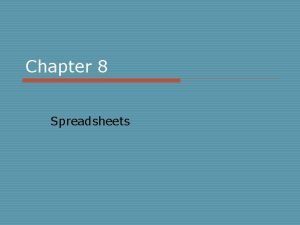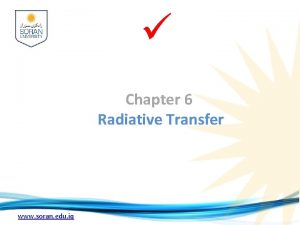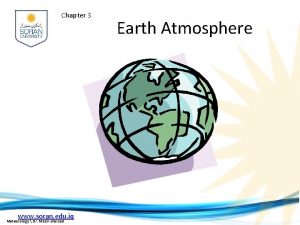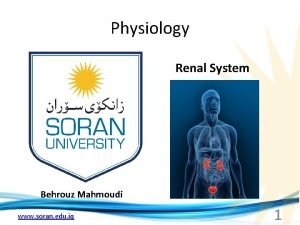www soran edu iq 1 Chapter five Exam














- Slides: 14

www. soran. edu. iq 1

Chapter five Exam 21 /04/ 2013 Superconductivity www. soran. edu. iq

What is a superconductor? Superconductors are materials that conduct electricity with no resistance. This means that, unlike the more familiar conductors such as copper or steel, a superconductor can carry a current indefinitely without losing any energy. They also have several other very important properties, such as the fact that no magnetic field can exist within a superconductor. www. soran. edu. iq

What is a superconductor? A superconductor is an element or metallic alloy which, when cooled to near absolute zero, dramatically lose all electrical resistance. In principle, superconductors can allow electrical current to flow without any energy loss Tin (Sn) www. soran. edu. iq

Types I and II Superconductors • There are thirty pure metals which exhibit zero resistivity at low temperatures and have the property of excluding magnetic fields from the interior of the superconductor (Meissner effect). They are called Type I superconductors. The superconductivity exists only below their critical temperatures and below a critical magnetic field strength. Type I superconductors are well described by the BCS theory (Bardeen, Cooper and Schrieffer). Starting in 1930 with lead-bismuth alloys, a number of alloys were found which exhibited superconductivity; they are called Type II superconductors. They were found to have much higher critical fields and therefore could carry much higher current densities while remaining in the superconducting state. www. soran. edu. iq

The Meissner Effect • When describing superconductors, it is the magnetic properties that are important. The superconductor is not a perfect conductor, but a perfect diamagnetic material with zero electrical resistance. This is known as the Meissner effect. The Meissner effect is the expulsion of a magnetic field from a superconductor during its transition to the superconducting state www. soran. edu. iq

www. soran. edu. iq

The time dependence of the magnetic field in a perfect conductor is described via the classical equation: (1) is known as the penetration depth. This has the solution: the magnetic field inside the perfect conductor obeys the condition www. soran. edu. iq

The Classification of Superconductors Difference between type 1 and type 2 superconductors www. soran. edu. iq

Difference between type 1 and type 2 superconductors Type 1. This type has a characteristic as shown in figure 1. The dependence of the critical magnetic field on the temperature can be seen clearly. Type 2. Discovered in 1962 this has two critical magnetic fields associated with its behaviour, enabling it to have a composite N/S structure. (N stands for normal state, S for the superconducting state). See figure 1. Above the first critical value Bc 1 the flux penetrates in a series of regular positioned filaments. The core of each filament is in the normal state, thus magnetic flux flows through in quanta given by equation 1. When the second critical field Bc 2 is reached, the flux penetrates completely and the material reverts to its normal state. www. soran. edu. iq

List of superconductors HC is a critical magnetic field in teslas www. soran. edu. iq

Applications 1. Superconducting electronics applications There are many thin film applications in ultra fast microelectronics or instrumentation 2. Magnetically-Levitated Train (Maglev Train) 3. MRI (Magnetic Resonance Image) 4. Nuclear Magnetic Resonance (NMR) www. soran. edu. iq

1) What is the Principle of Superconductivity? Superconducitivity is the concept of an electric current traveling through a conductor without electrical resistance. This conductor is the superconductor which usually exists at very low temperatures. The first superconductor was discovered by One's in 1910 s at about 4 degrees K. 2) What is a infinite conductor? Do you mean a perfect conductor (zero resistivity)? In that case, the difference is that a superconductor is a perfect conductor that is also a perfect diamagnet (the Meissner effect). www. soran. edu. iq

homework 1. What is BCS theory of superconductivity? 2. What is High-temperature superconductor? 3. What is Meissner effect? 4. What is Type I and Type II superconductors? www. soran. edu. iq
 Physics
Physics Www.soran.edu.iq
Www.soran.edu.iq Soran band
Soran band Soran band
Soran band Edu.sharif.edu
Edu.sharif.edu Exam hcmut
Exam hcmut And now with gleams of half-extinguished thought
And now with gleams of half-extinguished thought Five of five
Five of five 5 elements and 5 senses
5 elements and 5 senses Drum and colors macbeth
Drum and colors macbeth Www.bf.tku.edu.tw/files/news chapter 17
Www.bf.tku.edu.tw/files/news chapter 17 Chapter 17 darwin's theory of evolution
Chapter 17 darwin's theory of evolution Www.bf.tku.edu.tw/files/news chapter 17
Www.bf.tku.edu.tw/files/news chapter 17 Caring for yourself chapter 10
Caring for yourself chapter 10 Excel chapter 8 simulation exam
Excel chapter 8 simulation exam
